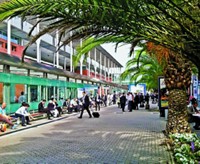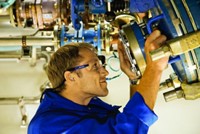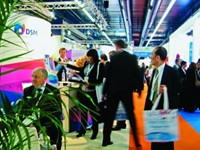Advertisement
Grab your lab coat. Let's get started
Welcome!
Welcome!
Create an account below to get 6 C&EN articles per month, receive newsletters and more - all free.
It seems this is your first time logging in online. Please enter the following information to continue.
As an ACS member you automatically get access to this site. All we need is few more details to create your reading experience.
Not you? Sign in with a different account.
Not you? Sign in with a different account.
ERROR 1
ERROR 1
ERROR 2
ERROR 2
ERROR 2
ERROR 2
ERROR 2
Password and Confirm password must match.
If you have an ACS member number, please enter it here so we can link this account to your membership. (optional)
ERROR 2
ACS values your privacy. By submitting your information, you are gaining access to C&EN and subscribing to our weekly newsletter. We use the information you provide to make your reading experience better, and we will never sell your data to third party members.
Business
Late Is Good In Contract Pharma
With loss of early-stage drug-manufacturing business, CPhI exhibitors vie for late-stage opportunities
by Rick Mullin
November 2, 2009
| A version of this story appeared in
Volume 87, Issue 44

The fine chemicals industry arrived at last year’s CPhI pharmaceutical ingredients conference in Frankfurt recovered from a long slump. Companies were especially enthusiastic about the prospect of increased business with major drug companies that were exiting the manufacturing of active pharmaceutical ingredients (APIs). But they were also shaking in their boots.
Just weeks before, the world economy had collapsed. Major markets for fine chemicals, including electronics and the auto industry, were heading for very tough times. Although the trajectory of the pharmaceutical market was harder to predict, no one doubted that a worldwide recession would impact business there as well.
At this year’s CPhI in Madrid, attendees agreed that 2009 was tough. The recession severely impacted revenues at several firms, especially those whose clients have candidates in early-stage development. Most, however, eked out some growth in pharmaceuticals, a market tied less to the vagaries of the economy than to the fortunes of individual clients and their drug candidates. As is typical in the fine chemicals sector, each company had its own angle and its own story to tell.
“This has been a challenging year,” said Aslam A. Malik, president of California-based Ampac Fine Chemicals. Companies making APIs for preclinical studies and Phase I clinical trials were particularly hurt, he said, as emerging pharmaceutical companies shelved early-stage projects and shifted limited resources to their most advanced drug candidates.
Guy Villax, chief executive officer of Hovione, a Portuguese contract manufacturer, agreed. “Phase I was terrible through the summer,” he said, because of the tightening of the credit market.
Malik and Villax, however, claim their businesses are poised to do well in the year ahead. Villax pointed to the continuing trend among drugmakers to exit manufacturing. Hovione took advantage of the trend earlier this year when it purchased an API facility in Cork, Ireland, from Pfizer (C&EN, June 8, page 30). The facility, which Pfizer had used to manufacture the active ingredient in the cholesterol-lowering drug Lipitor, already has three projects, Villax said. “Only one of these projects was inherited from Pfizer.”
Hovione, which works on drugs at all phases of clinical development, has positioned itself to serve customers that need specialized technologies, especially particle design. Although business is currently slow because of the economy, Villax sees an upturn ahead, bolstered in part by spray drying for biologics, a novel application for the technology. Hovione’s sales grew 21% last year, and Villax expects 12–16% growth this year.
Ampac had a tough third quarter, with sales down nearly 12% compared with the third quarter of 2008. “But last year was exceptional,” Malik said. Many customers were building inventory at the time, and this year they were working it off. New business inquiries were slow in the first half of the year but began picking up over the summer, he said.
Specialized technology is a major selling point for Ampac. Like Hovione, Ampac concentrates on later-stage drug candidates, half of which are for major drug companies. “We are getting very specific, targeted inquiries for projects in technical areas we are familiar with,” Malik said. These include energetic reactions, high-potency chemistry, and simulated moving-bed separations.
Ampac added to its technology arsenal recently when it validated a new Hastelloy liquid-liquid centrifuge for production of a commercial API. The centrifuge enables high-throughput phase splitting, an extraction step involved in nearly all separation processes. Continuous-process manufacturing, another focus at Ampac, is likely to boost future growth, Malik said.
Chemie Uetikon , a German maker of generic and custom APIs, also had a strong 2008 and difficult 2009, according to CEO Heinz Sieger. “We felt the crush at the end of last year, but the problem started in 2007,” he said, referring to early indicators that the economy was headed for trouble. “Everybody ignored it.”
Although the broader economy is still soft, the pharmaceutical industry is poised for a rebound, Siegler predicted. “I think we’ve hit bottom,” he said. “The summer was very difficult.” Inquiries are picking up, he said, speculating that drugmakers have worked off inventory and may be ready to proceed on stalled projects.
Siegfried CEO Rudolf Hanko claims his company, a Swiss API maker and finished-drug formulator, has done fairly well over the past year. “It’s a unique company in that it brings together primary and secondary manufacturing,” said Hanko, who came to the position this year after running Evonik Industries’ exclusive synthesis and amino acids business.
Contract manufacturers have not sufficiently exploited the synergies between API and final-dosage product manufacturing, Hanko contends. “The percentage of drugs requiring advanced APIs and/or drug product formulation is increasing in drug company pipelines,” he said.
Siegfried has been active on a few fronts. It recently opened a new laboratory in Zofingen, Switzerland, that consolidates analytical research services. And Siegfried has developed a drug powder inhaler technology called PulmoJet that it offers to drugmakers.
“But our core business is custom manufacturing—process development, manufacturing, and formulation,” Hanko emphasized. Growth in these areas will continue, he said, as large drug companies exit manufacturing to concentrate on R&D and marketing.
Siegfried’s sales for the first nine months of 2009 remained flat with the same period last year at about $197 million.
Several CPhI exhibitors reported scaling back their nonpharmaceutical fine chemical activities. France’s PCAS laid off 20% of its staff in that area over the past year, as its nonpharma business dropped from 45% to 30% of company sales. Vincent Touraille, chief operating officer, said that although PCAS’s pharmaceutical segment is doing better in 2009 than it did last year, overall sales will be down. At $252 million, sales last year were already off by 9%.
Having experienced a postponement of early-stage drug development contracts, PCAS is focusing on later-stage projects with major pharmaceutical companies, Touraille said. The tight credit market, however, has not altered PCAS’s plans to pursue business with U.S. biotech firms through a research and manufacturing services venture it formed recently with California’s Nanosyn.
David Ager, principal scientist at DSM, said a sectorwide shift of resources to more-advanced compounds is likely to have a stultifying effect on drug discovery and development. “A lot of people have let go of their medicinal chemists,” he said, a move that bodes ill for replenishing industry pipelines.
Yet Ager said he has not seen a drop in new business leads on compounds in Phase II and Phase III trials. DSM’s background in finished-dose formulation has helped land new contracts, he said. The company’s generic API partnership with India’s Arch Pharmalabs also helped generate business.
DSM’s pharmaceutical products division logged $750 million in sales last year, growing “with the market” at about 5%, said Luca Mantovani, president of the division’s pharmaceuticals and exclusive synthesis unit. Outsourcing trends favor companies with specialized technologies, which for DSM include microreactors, biocatalysis, and energetic reactions, he said. “DSM has invested in sophisticated technologies that have gained credibility,” he said. “In a challenging year, you look to a custom orientation.”
Some firms say they continue to do well this year. Fabbrica Italiana Sintetici, based in Vicenza, Italy, had its best year ever in 2008, according to General Manager Roger Laforce. FIS’s sales grew 22% to reach $250 million, and Laforce said he expects to achieve comparable sales in 2009.
FIS, Laforce noted, is doing well now partly because of its focus on APIs for late-phase clinical trials. In recent years, he notes, such custom synthesis projects have grown to represent 75% of revenue, up from a historic 50/50 split with generic APIs. FIS was also fortunate to have a contract to produce a generic analgesic for a firm whose main competitor exited the market. FIS has already upped production of the drug.
FIS’s earnings will be only minimally affected by an explosion that destroyed half of one of its five manufacturing plants in Vicenza over the summer, according to Laforce. The accident, caused by a runaway reaction associated with a solvent recovery vessel, resulted in one injury.
In contrast with FIS, Switzerland’s Solvias focuses on early-stage development. According to Michael Becker, head of marketing, the firm was adversely affected by the drying up of financing for biotech and start-up drug companies.
Nonetheless, Solvias experienced 10% growth in 2008 and has maintained that sales level this year, partly because of a portfolio of technologies that includes specialized catalysts, Becker said. “Also, we have hundreds of clients,” he said. “Some of them have been lucky.”
This year, Solvias began producing kilogram quantities of APIs certified to current Good Manufacturing Practice (cGMP) standards, Becker said. The new capability, he said, allows customers contracting for process R&D to proceed to preclinical and Phase I API production without technology transfer between contractors.
Although most CPhI attendees agreed that tough times are likely to continue, they kept returning to the theme of more outsourcing on the part of big drug companies. Evidence that this trend still has legs came during the conference when Evonik announced the acquisition of Eli Lilly & Co.’s Tippecanoe Laboratories plant in Lafayette, Ind. The deal came with a nine-year supply and services agreement.
“There is growing demand for advanced cGMP manufacturing,” said Klaus Stingl, head of key accounts for custom synthesis at Evonik. “Exclusive synthesis is still a stable business.”





Join the conversation
Contact the reporter
Submit a Letter to the Editor for publication
Engage with us on Twitter